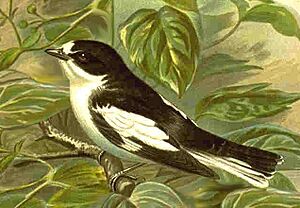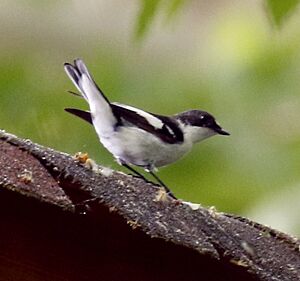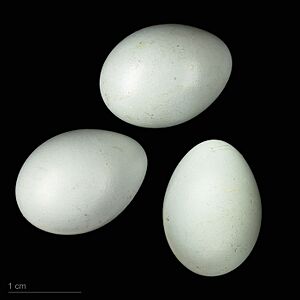Semicollared flycatcher facts for kids
Quick facts for kids Semicollared flycatcher |
|
|---|---|
 |
|
| Conservation status | |
| Scientific classification | |
| Genus: |
Ficedula
|
| Species: |
semitorquata
|
The semicollared flycatcher (Ficedula semitorquata) is a small songbird that belongs to the Old World flycatcher family. It is one of four types of "black-and-white flycatchers" found in the western part of Europe and Asia.
These birds make their homes in mountain forests in southeastern Europe, like the Balkan Peninsula, all the way to Northwest Iran. They are migratory birds, meaning they travel long distances. When winter comes, they fly south to Central and Eastern Africa. Sometimes, they might even visit western Europe, though this is rare. Scientists have used small tracking devices called geolocators to learn that weather during their spring journey can really affect when they arrive and if they survive.
Contents
What Does a Semicollared Flycatcher Look Like?
This bird is about 12 to 13.5 centimeters (about 5 inches) long. It looks a bit like a mix between the collared flycatcher and the European pied flycatcher. In fact, some people used to think it was just a type of collared flycatcher.
Male Semicollared Flycatcher
When a male semicollared flycatcher is ready to breed, it has a mostly black back and white belly. It has a white "half-collar" around its neck, which goes further back than on the pied flycatcher. You can also see a large white patch on its wings and a lot of white on the sides of its tail. It has a big white patch on its forehead and a light grey area on its lower back. Its beak is black and shaped like a wide, pointed tool, perfect for catching insects in the air. These birds mostly catch insects while flying. They don't often hunt for caterpillars on tree leaves, unlike the pied flycatcher.
Female and Young Semicollared Flycatchers
Female and young semicollared flycatchers, as well as males not ready to breed, have light brown feathers instead of black. This can make them very hard to tell apart from other Ficedula flycatchers, especially the collared flycatcher. One small difference is that semicollared flycatchers might have a second white bar on their wings, but it's not always easy to see this in nature.
Where Do Semicollared Flycatchers Live?
Semicollared flycatchers prefer to live in forests with deciduous trees, which are trees that lose their leaves in the fall. They especially like forests with oak and hornbeam trees in mountainous areas.
Nesting and Reproduction
These birds build their nests in natural holes found in trees or in old nests made by woodpeckers. They can also use special nest-boxes that people put up for them. A female semicollared flycatcher usually lays between 4 and 7 eggs.
What Does a Semicollared Flycatcher Sound Like?
The song of the semicollared flycatcher is also a mix between the collared and pied flycatchers. It has slow, stretched-out whistle sounds, but also some parts that have a steady beat.




